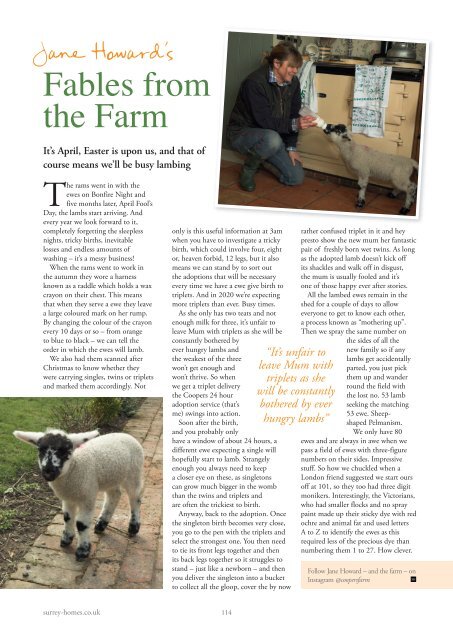Surrey Homes | SH66 | April 2020 | Gardens supplement
The lifestyle magazine for Surrey - Inspirational Interiors, Fabulous Fashion, Delicious Dishes
The lifestyle magazine for Surrey - Inspirational Interiors, Fabulous Fashion, Delicious Dishes
Create successful ePaper yourself
Turn your PDF publications into a flip-book with our unique Google optimized e-Paper software.
Jane Howard’s<br />
Fables from<br />
the Farm<br />
It’s <strong>April</strong>, Easter is upon us, and that of<br />
course means we’ll be busy lambing<br />
The rams went in with the<br />
ewes on Bonfire Night and<br />
five months later, <strong>April</strong> Fool’s<br />
Day, the lambs start arriving. And<br />
every year we look forward to it,<br />
completely forgetting the sleepless<br />
nights, tricky births, inevitable<br />
losses and endless amounts of<br />
washing – it’s a messy business!<br />
When the rams went to work in<br />
the autumn they wore a harness<br />
known as a raddle which holds a wax<br />
crayon on their chest. This means<br />
that when they serve a ewe they leave<br />
a large coloured mark on her rump.<br />
By changing the colour of the crayon<br />
every 10 days or so – from orange<br />
to blue to black – we can tell the<br />
order in which the ewes will lamb.<br />
We also had them scanned after<br />
Christmas to know whether they<br />
were carrying singles, twins or triplets<br />
and marked them accordingly. Not<br />
only is this useful information at 3am<br />
when you have to investigate a tricky<br />
birth, which could involve four, eight<br />
or, heaven forbid, 12 legs, but it also<br />
means we can stand by to sort out<br />
the adoptions that will be necessary<br />
every time we have a ewe give birth to<br />
triplets. And in <strong>2020</strong> we’re expecting<br />
more triplets than ever. Busy times.<br />
As she only has two teats and not<br />
enough milk for three, it’s unfair to<br />
leave Mum with triplets as she will be<br />
constantly bothered by<br />
ever hungry lambs and<br />
the weakest of the three<br />
won’t get enough and<br />
won’t thrive. So when<br />
we get a triplet delivery<br />
the Coopers 24 hour<br />
adoption service (that’s<br />
me) swings into action.<br />
Soon after the birth,<br />
and you probably only<br />
have a window of about 24 hours, a<br />
different ewe expecting a single will<br />
hopefully start to lamb. Strangely<br />
enough you always need to keep<br />
a closer eye on these, as singletons<br />
can grow much bigger in the womb<br />
than the twins and triplets and<br />
are often the trickiest to birth.<br />
Anyway, back to the adoption. Once<br />
the singleton birth becomes very close,<br />
you go to the pen with the triplets and<br />
select the strongest one. You then need<br />
to tie its front legs together and then<br />
its back legs together so it struggles to<br />
stand – just like a newborn – and then<br />
you deliver the singleton into a bucket<br />
to collect all the gloop, cover the by now<br />
“It’s unfair to<br />
leave Mum with<br />
triplets as she<br />
will be constantly<br />
bothered by ever<br />
hungry lambs”<br />
rather confused triplet in it and hey<br />
presto show the new mum her fantastic<br />
pair of freshly born wet twins. As long<br />
as the adopted lamb doesn’t kick off<br />
its shackles and walk off in disgust,<br />
the mum is usually fooled and it’s<br />
one of those happy ever after stories.<br />
All the lambed ewes remain in the<br />
shed for a couple of days to allow<br />
everyone to get to know each other,<br />
a process known as “mothering up”.<br />
Then we spray the same number on<br />
the sides of all the<br />
new family so if any<br />
lambs get accidentally<br />
parted, you just pick<br />
them up and wander<br />
round the field with<br />
the lost no. 53 lamb<br />
seeking the matching<br />
53 ewe. Sheepshaped<br />
Pelmanism.<br />
We only have 80<br />
ewes and are always in awe when we<br />
pass a field of ewes with three-figure<br />
numbers on their sides. Impressive<br />
stuff. So how we chuckled when a<br />
London friend suggested we start ours<br />
off at 101, so they too had three digit<br />
monikers. Interestingly, the Victorians,<br />
who had smaller flocks and no spray<br />
paint made up their sticky dye with red<br />
ochre and animal fat and used letters<br />
A to Z to identify the ewes as this<br />
required less of the precious dye than<br />
numbering them 1 to 27. How clever.<br />
Follow Jane Howard – and the farm – on<br />
Instagram @coopersfarm<br />
surrey-homes.co.uk<br />
114


















